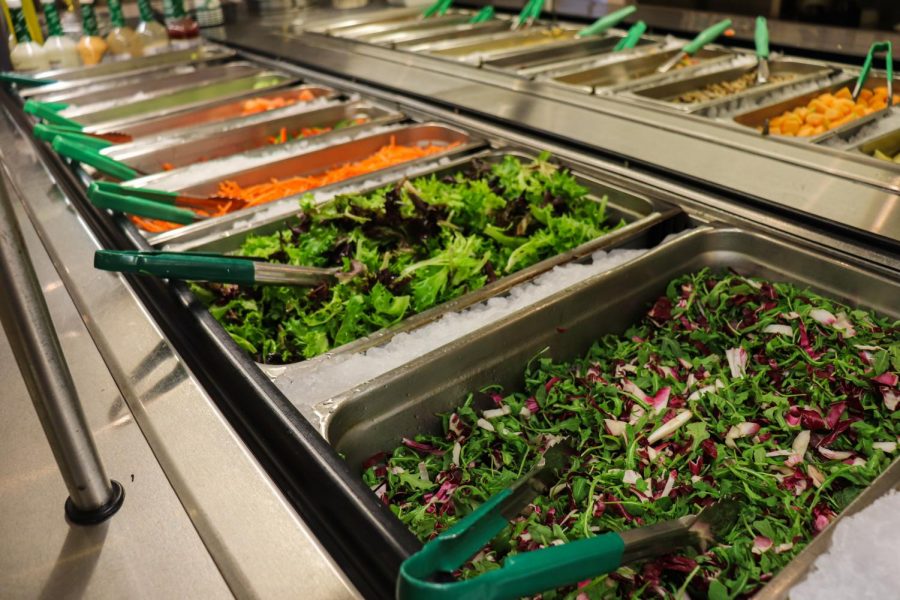Keto Food for Thought: Stop Complaining About the Dining Room
ANNA KYRZANEKAS/THE OBSERVER
The Fordham Dining Room offers a variety of nutritious food for students to peruse and consume every day.
February 3, 2020
As I walk into the Fordham Lincoln Center Community Dining Room, I pull my ID card from my wallet and offer it to the woman managing this evening’s swipes. As she processes my card, I stand on my tiptoes, eagerly sneaking a peek at the food options from which I will be creating a tasty, ketogenic dinner.
Fordham students are notorious for the disdain we hold for the food at the Community Dining Room. Each day, I am privy to conversations disparaging the menus and their options. Students, many of whom do not have dietary restrictions, complain about the taste of the wraps or the texture of the ice cream or the flakiness of the pastries. Refraining from offering my commentary in these situations, I hold my tongue and a different perspective.
The origin of the ketogenic diet, which can be traced back to the early 20th century, was initially formulated by doctors seeking a cure for epilepsy. The diet works by inhibiting consumption of carbohydrates, both simple and complex, to 20 grams or less every 24 hours. This privation causes the body to secrete ketones, which in turn cause the body to burn fat for energy instead of carbohydrates broken down into sugars. Once this process begins, one enters the state of ketosis. The keto diet is simply the training of one’s body to use an alternative energy source.
While controversial due to the heavy restrictions on both simple and complex carbohydrates, this diet is a common nutritional path for athletes who require small amounts of adipose tissue (fat) and seek to maintain acquired lean muscle as well as people with epilepsy who seek alternative methods of reducing seizures and those with PCOS who desire management of weight fluctuations, hormonal imbalances and menstrual cycle irregularity.
Following a keto diet requires me to severely restrict my carbohydrate intake. While this typically means transcending the confines of American food staples and getting creative with ingredient combinations, I don’t mind; I actually take pleasure in the culinary adventures I embark upon each day. I eschew traditional pasta, pizza, pastries and potatoes, instead incorporating non-starchy vegetables, fruits and certain meats as the main base of each of my meals. Each day, I dive into the diverse array of foods prepared by the Dining Room to concoct both a satiating and savory supper.
Grabbing a paper plate from beneath the yogurt bar, I begin to circle around the Dining Room’s center island before seizing four pieces of broccoli, some cucumber slices and several sliced tomatoes. After constructing a base, I feather the green and red foundation with crisp romaine lettuce and spinach. Deciding the tertiary level will consist of protein-rich toppings, I decorate the top of my plate with grilled chicken slices and hastily dice a boiled egg from the fruit section, dispersing the little white and yellow cubes around my plate. I walk back to the veggie section and drizzle apple cider vinegar over my greens with the panache of a confident Food Network contestant before settling at a window-side table to enjoy my (keto) dinner.
Although it can be difficult to parse together a palatable plate when the majority of food in the Dining Room is carbohydrate-laden, I always feel satiated and content with my nutritional choices at the end of my meal. On a given day, more than two thirds of the food offered may be off-limits for me, but I still manage to satisfy both my dietary restrictions and my taste buds.
Despite the fact that I follow a significantly restricted nutritional regimen and am relegated to getting creative at the salad bar most nights, I neglect to complain about the food offered in the Dining Room. It would be lovely to have access to keto-friendly bread, higher fat yogurt and a diverse array of lean meats each night, but I conclude each day with all of my nutritional needs met. Compared to the lack of not only choice but also availability of food many people experience due to the global famine epidemic, my fulfilling experience is an anomaly that I am extremely fortunate to experience.
The complaints concerning the Community Dining Room are mostly shallow reflections coming from students who are likely used to consuming their favorite recipes and brands on particular schedules. These inaccurate criticisms, which students bandy back and forth with alarming nonchalance, indicate a serious misappreciation of the food options at Fordham. In other words, because the Dining Room fails to replicate your ideal version of macaroni and cheese or the tomato bisque neglects to complement the more substantive foods from Under The Hood or Foodology does not mean the Dining Room is lacking or inadequate in any way. The purpose of the Dining Room is to provide all students with an abundance of well-prepared, healthy food options each day, and despite my considerable dietary restrictions I have never been less than impressed with my meal curations.
While this disrespectful trend may be more of a social habit than failure to check one’s eating privileges, Fordham students should recognize how lucky we are to possess daily access to such a high quantity of high quality food. Transition from complaining about dining options to advocating for ones that align with your food palette, if the menu selections disrupt your appetite so profoundly. Better yet, choose to appreciate the foods we have in the Dining Room and harness your creativity to prepare a plate of your own creation. Unless you follow certain dietary regimens, be they for medical or ethical reasons, then you likely have access to a cornucopia of foods each day that you can consume without compromising your health or moral compass.
Some food for thought: We are extraordinarily lucky to have access to the open pantry that is the Community Dining Room, even those of us who can only afford to visit once a day. Stop denigrating the abundant, diverse and nutritious culinary buffet you have the privilege of sifting through. We are mere outliers on the graph of human history, our inordinate access to food falling in line with the kings and queens of centuries past. Let’s develop appurtenant perspective and demonstrate gratitude for the Community Dining Room.













